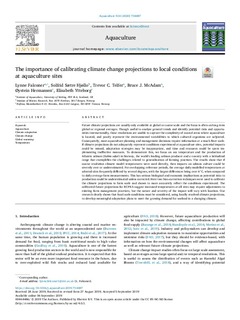| dc.description.abstract | Future climate projections are usually only available at global or coarse scale and the focus is often on long-term global or regional averages. Though useful to analyse general trends and identify potential risks and opportunities internationally, these resolutions are unable to capture the complexity of coastal areas where aquaculture is located, and poorly represent the environmental variabilities to which cultured organisms are subjected. Consequently, most aquaculture planning and management decisions require information at a much finer scale. If climate projections do not adequately represent conditions experienced at aquaculture sites, potential impacts could be missed, adaptation strategies may be inappropriate, and time and resources could be spent implementing ineffective measures. To demonstrate this, we focus on sea temperature and the production of Atlantic salmon (Salmo salar) in Norway, the world's leading salmon producer and a country with a latitudinal range that exemplifies the challenges related to generalization of farming practises. The results show that if coarse resolution climate model temperatures were used directly, then impacts on salmon culture could be severely over or underestimated. For overlapping reference periods, the average daily modelled temperatures at selected sites frequently differed by several degrees, with the largest differences being over 6 °C, when compared to daily average farm measurements. This has serious biological and economic implications as potential risks to production could be underestimated unless corrected. Here two bias-correction techniques were used to calibrate the climate projections to farm scale and shown to more accurately reflect the conditions experienced. The calibrated future projections for RCP4.5 suggest increased temperatures at all sites may require adjustments to existing farm management practices, but the nature and severity of the impact will vary with location. Our research clearly shows that local scale conditions must be considered, using locally resolved climate projections, to develop meaningful adaptation plans to meet the growing demand for seafood in a changing climate. | |
